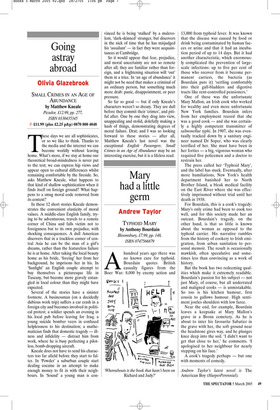Mary had a little germ
Andrew Taylor
TYPHOID MARY by Anthony Bourdain Bloomsbury, £7.99, pp. 148, ISBN 0747566879 Ahundred years ago there was no known cure for typhoid. Bourdain quotes British casualty figures from the Boer War: 8,000 by enemy action and 13,000 from typhoid fever. It was known that the disease was caused by food or drink being contaminated by human faeces or urine and that it had an incubation period of up to 14 days. But it had another characteristic, which enormously complicated the prevention of largescale infections: up to five per cent of those who recover from it become permanent carriers, the bacteria (as Bourdain puts it) ‘settling comfortably into their gall-bladders and digestive tracts like rent-controlled pensioners.’ One of these was the unfortunate Mary Mallon, an Irish cook who worked for wealthy and even more unfortunate New York families. Bourdain infers from her employment record that she was a good cook — and she was certainly a highly competent transmitter of salmonellae typhi. In 1907, she was eventually tracked down by a sanitary engineer named Dr Soper, who was clearly terrified of her. She must have been in her forties — a big, vigorous woman who required five policemen and a doctor to restrain her.
The press called her ‘Typhoid Mary’, and the label has stuck. Eventually, after more humiliations, New York’s health department banished her to North Brother Island, a bleak medical facility on the East River where she was effectively imprisoned without trial until her death in 1938.
For Bourdain, this is a cook’s tragedy: Mary’s only crime had been to cook too well, and for this society made her an outcast. Bourdain’s tragedy, on the other hand, is that so little is known about the woman as opposed to the typhoid carrier. His narrative rambles from the history of cookery to Irish emigration, from urban sanitation to personal memoir. The result is occasionally mawkish, often speculative and sometimes less than convincing as a work of history.
But the book has two redeeming qualities which make it extremely readable. Bourdain’s passion for his subject — not just Mary, of course, but all underrated and maligned cooks — is unmistakable. So too is his kitchen humour, first cousin to gallows humour. High sentiment jostles shoulders with low farce.
Near the end, for example, Bourdain leaves a keepsake at Mary Mallon’s grave in a Bronx cemetery. As he is about to inter his favourite Sabatier in the grave with her, the soft ground near the headstone gives way, and he plunges knee deep into the soil. ‘I didn’t want to get that close to her,’ he comments. ‘I apologised to her neighbour for nearly stepping on his face.’ A cook’s tragedy perhaps — but one with moments of comedy.
Andrew Taylor’s latest novel is The American Boy (HarperPerennial).


























































 Previous page
Previous page